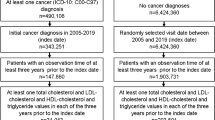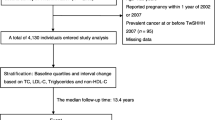Abstract
Experimental studies provided evidence about mechanisms by which cholesterol, especially high density lipoprotein cholesterol (HDL-C), could influence carcinogenesis, notably through antioxidant and anti-inflammatory properties. However, prospective studies that investigated the associations between specific lipid metabolism biomarkers and cancer risk provided inconsistent results. The objective was to investigate the prospective associations between total cholesterol (T-C), HDL-C, low density lipoprotein cholesterol, apolipoproteins A1 (apoA1) and B, and triglycerides and overall, breast and prostate cancer risk. Analyses were performed on 7,557 subjects of the Supplémentation en Vitamines et Minéraux Antioxydants Study, a nationwide French cohort study. Biomarkers of lipid metabolism were measured at baseline and analyzed regarding the risk of first primary incident cancer (N = 514 cases diagnosed during follow-up, 1994–2007), using Cox proportional hazards models. T-C was inversely associated with overall (HR1mmol/L increment = 0.91, 95 % CI 0.82–1.00; P = 0.04) and breast (HR1mmol/L increment = 0.83, 95 % CI 0.69–0.99; P = 0.04) cancer risk. HDL-C was also inversely associated with overall (HR1mmol/L increment = 0.61, 95 % CI 0.46–0.82; P = 0.0008) and breast (HR1mmol/L increment = 0.48, 95 % CI 0.28–0.83; P = 0.009) cancer risk. Consistently, apoA1 was inversely associated with overall (HR1g/L increment = 0.56, 95 % CI 0.39–0.82; P = 0.003) and breast (HR1g/L increment = 0.36, 95 % CI 0.18–0.73; P = 0.004) cancer risk. This prospective study suggests that pre-diagnostic serum levels of T-C, HDL-C and ApoA1 are associated with decreased overall and breast cancer risk. The confirmation of a role of cholesterol components in cancer development, by further large prospective and experimental studies, may have important implications in terms of public health, since cholesterol is already crucial in cardiovascular prevention.
Similar content being viewed by others

Abbreviations
- ApoA1:
-
Apolipoprotein A1
- ApoB:
-
Apolipoprotein B
- BMI:
-
Body mass index
- CI:
-
Confidence interval
- HDL-C:
-
High density lipoprotein cholesterol
- HR:
-
Hazard ratio
- LDL-C:
-
Low density lipoprotein cholesterol
- Q:
-
Quartile
- SU.VI.MAX:
-
Supplémentation en Vitamines et Minéraux Antioxydants
- T-C:
-
Total cholesterol
References
Huxley R, Lewington S, Clarke R. Cholesterol, coronary heart disease and stroke: a review of published evidence from observational studies and randomized controlled trials. Semin Vasc Med. 2002;2:315–23.
Law MR, Thompson SG. Low serum cholesterol and the risk of cancer: an analysis of the published prospective studies. Cancer Causes Control. 1991;2:253–61.
Melvin JC, Holmberg L, Rohrmann S, et al. Serum lipid profiles and cancer risk in the context of obesity: four meta-analyses. J Cancer Epidemiol. 2013;2013:823849.
Bjorge T, Lukanova A, Tretli S, et al. Metabolic risk factors and ovarian cancer in the metabolic syndrome and cancer project. Int J Epidemiol. 2011;40:1667–77.
Eichholzer M, Stahelin HB, Gutzwiller F, et al. Association of low plasma cholesterol with mortality for cancer at various sites in men: 17-y follow-up of the prospective Basel study. Am J Clin Nutr. 2000;71:569–74.
Nago N, Ishikawa S, Goto T, et al. Low cholesterol is associated with mortality from stroke, heart disease, and cancer: the Jichi Medical School Cohort Study. J Epidemiol. 2011;21:67–74.
Strohmaier S, Edlinger M, Manjer J, et al. Total serum cholesterol and cancer incidence in the metabolic syndrome and cancer project (Me-Can). PLoS One. 2013;8:e54242.
Kitahara CM, de Berrington GA, Freedman ND, et al. Total cholesterol and cancer risk in a large prospective study in Korea. J Clin Oncol. 2011;29:1592–8.
Iso H, Ikeda A, Inoue M, et al. Serum cholesterol levels in relation to the incidence of cancer: the JPHC study cohorts. Int J Cancer. 2009;125:2679–86.
Jacobs EJ, Gapstur SM. Cholesterol and cancer: answers and new questions. Cancer Epidemiol Biomarkers Prev. 2009;18:2805–6.
Henriksson P, Eriksson M, Ericsson S, et al. Hypocholesterolaemia and increased elimination of low-density lipoproteins in metastatic cancer of the prostate. Lancet. 1989;2:1178–80.
Vitols S, Gahrton G, Bjorkholm M, et al. Hypocholesterolaemia in malignancy due to elevated low-density-lipoprotein-receptor activity in tumour cells: evidence from studies in patients with leukaemia. Lancet. 1985;2:1150–4.
Dessi S, Batetta B, Pulisci D, et al. Altered pattern of lipid metabolism in patients with lung cancer. Oncology. 1992;49:436–41.
Ahn J, Lim U, Weinstein SJ, et al. Prediagnostic total and high-density lipoprotein cholesterol and risk of cancer. Cancer Epidemiol Biomarkers Prev. 2009;18:2814–21.
Soran H, Hama S, Yadav R, et al. HDL functionality. Curr Opin Lipidol. 2012;23:353–66.
von Eckardstein A, Hersberger M, Rohrer L. Current understanding of the metabolism and biological actions of HDL. Curr Opin Clin Nutr Metab Care. 2005;8:147–52.
Agnoli C, Berrino F, Abagnato CA, et al. Metabolic syndrome and postmenopausal breast cancer in the ORDET cohort: a nested case–control study. Nutr Metab Cardiovasc Dis. 2010;20:41–8.
Furberg AS, Veierod MB, Wilsgaard T, et al. Serum high-density lipoprotein cholesterol, metabolic profile, and breast cancer risk. J Natl Cancer Inst. 2004;96:1152–60.
Gaard M, Tretli S, Urdal P. Risk of breast cancer in relation to blood lipids: a prospective study of 31,209 Norwegian women. Cancer Causes Control. 1994;5:501–9.
Hoyer AP, Engholm G. Serum lipids and breast cancer risk: a cohort study of 5,207 Danish women. Cancer Causes Control. 1992;3:403–8.
Inoue M, Noda M, Kurahashi N, et al. Impact of metabolic factors on subsequent cancer risk: results from a large-scale population-based cohort study in Japan. Eur J Cancer Prev. 2009;18:240–7.
Kucharska-Newton AM, Rosamond WD, Mink PJ, et al. HDL-cholesterol and incidence of breast cancer in the ARIC cohort study. Ann Epidemiol. 2008;18:671–7.
Melvin JC, Seth D, Holmberg L, et al. Lipid profiles and risk of breast and ovarian cancer in the Swedish AMORIS study. Cancer Epidemiol Biomarkers Prev. 2012;21:1381–4.
Moorman PG, Hulka BS, Hiatt RA, et al. Association between high-density lipoprotein cholesterol and breast cancer varies by menopausal status. Cancer Epidemiol Biomarkers Prev. 1998;7:483–8.
Esposito K, Chiodini P, Capuano A, et al. Metabolic syndrome and postmenopausal breast cancer: systematic review and meta-analysis. Menopause. 2013;20:1301–9.
Mondul AM, Weinstein SJ, Virtamo J, et al. Serum total and HDL cholesterol and risk of prostate cancer. Cancer Causes Control. 2011;22:1545–52.
Van Hemelrijck M, Walldius G, Jungner I, et al. Low levels of apolipoprotein A-I and HDL are associated with risk of prostate cancer in the Swedish AMORIS study. Cancer Causes Control. 2011;22:1011–9.
Esposito K, Chiodini P, Capuano A, et al. Effect of metabolic syndrome and its components on prostate cancer risk: meta-analysis. J Endocrinol Invest. 2013;36:132–9.
Hercberg S, Galan P, Preziosi P, et al. The SU.VI.MAX Study: a randomized, placebo-controlled trial of the health effects of antioxidant vitamins and minerals. Arch Intern Med. 2004;164:2335–42.
Stamey TA. Second Stanford conference on international standardization of prostate-specific antigen immunoassays: September 1 and 2, 1994. Urology. 1995;45:173–84.
Le Moullec N, Deheeger M, Preziosi P, et al. Validation du manuel photos utilisé pour l’enquête alimentaire de l’étude SU.VI.MAX. Cah Nutr Diet. 1996;31:158–64.
Hercberg S. Table de composition SU.VI.MAX des aliments. Paris: Les éditions INSERM/Economica; 2005.
Kritchevsky SB, Wilcosky TC, Morris DL, et al. Changes in plasma lipid and lipoprotein cholesterol and weight prior to the diagnosis of cancer. Cancer Res. 1991;51:3198–203.
Planella T, Cortes M, Martinez-Bru C, et al. Calculation of LDL-cholesterol by using apolipoprotein B for classification of nonchylomicronemic dyslipemia. Clin Chem. 1997;43:808–15.
Friedewald WT, Levy RI, Fredrickson DS. Estimation of the concentration of low-density lipoprotein cholesterol in plasma, without use of the preparative ultracentrifuge. Clin Chem. 1972;18:499–502.
Huang R, Silva RA, Jerome WG, et al. Apolipoprotein A–I structural organization in high-density lipoproteins isolated from human plasma. Nat Struct Mol Biol. 2011;18:416–22.
Aleksandrova K, Boeing H, Jenab M, et al. Metabolic syndrome and risks of colon and rectal cancer: the European prospective investigation into cancer and nutrition study. Cancer Prev Res (Phila). 2011;4:1873–83.
Esposito K, Chiodini P, Capuano A, et al. Metabolic syndrome and endometrial cancer: a meta-analysis. Endocrine. 2013;. doi:10.1007/s12020-013-9973-3.
Mihaylova B, Emberson J, Blackwell L, et al. The effects of lowering LDL cholesterol with statin therapy in people at low risk of vascular disease: meta-analysis of individual data from 27 randomised trials. Lancet. 2012;380:581–90.
Schatzkin A, Hoover RN, Taylor PR, et al. Serum cholesterol and cancer in the NHANES I epidemiologic followup study. National Health and Nutrition Examination Survey. Lancet. 1987;2:298–301.
Cleeman JI, Grundy SM, Becker D, Clark LT. Expert panel on detection, evaluation, and treatment of high blood cholesterol in adults. Executive summary of the third report of the National Cholesterol Education Program (NCEP) Adult Treatment Panel (ATP III). Jama. 2001;285:2486–97.
Leon AS, Sanchez OA. Response of blood lipids to exercise training alone or combined with dietary intervention. Med Sci Sports Exerc. 2001;33:S502–15.
World Cancer Research Fund/American Institute for Cancer Research. Food, nutrition, physical activity, and the prevention of cancer: a global perspective. Washington, DC: AICR; 2007.
Kraus WE, Houmard JA, Duscha BD, et al. Effects of the amount and intensity of exercise on plasma lipoproteins. N Engl J Med. 2002;347:1483–92.
Esteve E, Ricart W, Fernandez-Real JM. Dyslipidemia and inflammation: an evolutionary conserved mechanism. Clin Nutr. 2005;24:16–31.
Beynen AC, Katan MB, Van Zutphen LF. Hypo- and hyperresponders: individual differences in the response of serum cholesterol concentration to changes in diet. Adv Lipid Res. 1987;22:115–71.
Ordovas JM, Lopez-Miranda J, Mata P, et al. Gene-diet interaction in determining plasma lipid response to dietary intervention. Atherosclerosis. 1995;118(Suppl.):S11–27.
Al-Delaimy WK, Jansen EH, Peeters PH, et al. Reliability of biomarkers of iron status, blood lipids, oxidative stress, vitamin D, C-reactive protein and fructosamine in two Dutch cohorts. Biomarkers. 2006;11:370–82.
Bairaktari E, Hatzidimou K, Tzallas C, et al. Estimation of LDL cholesterol based on the Friedewald formula and on apo B levels. Clin Biochem. 2000;33:549–55.
Binder-Foucard F, Belot A, Delafosse P, et al. National estimate of the incidence and mortality from cancer in France between 1980 and 2012. Part 1—solid tumors. Saint-Maurice: Institut de veille sanitaire; 2013.
Anderson KM, Odell PM, Wilson PW, et al. Cardiovascular disease risk profiles. Am Heart J. 1991;121:293–8.
World Health Organization. Cardiovascular diseases (CVDs). Fact sheet no. 317. In: Media centre. World Health Organization; 2013. http://www.who.int/mediacentre/factsheets/fs317/en/. Accessed 12 July 2013.
World Health Organization. Cancer. Fact sheet no. 297. In: Media centre. World Health Organization. 2013. http://www.who.int/mediacentre/factsheets/fs297/en/index.html. Accessed July 12 2013.
Acknowledgments
The authors thank Gwenael Monot, Younes Esseddik, Paul Flanzy, Mohand Ait Oufella, Yasmina Chelghoum, and Than Duong Van (computer scientists), Florence Charpentier (dietitian), Nathalie Arnault, Véronique Gourlet, Fabien Szabo, Laurent Bourhis, and Stephen Besseau (statisticians), and Rachida Mehroug (logistics assistant) for their technical contribution to the SU.VI.MAX study. This work was supported by the Institut National de la Santé et de la Recherche Médicale (INSERM U557); the Institut National de la Recherche Agronomique (INRA U1125); and the Université Paris 13.
Conflict of interest
The authors declare that they have no conflict of interest.
Author information
Authors and Affiliations
Corresponding author
Rights and permissions
About this article
Cite this article
His, M., Zelek, L., Deschasaux, M. et al. Prospective associations between serum biomarkers of lipid metabolism and overall, breast and prostate cancer risk. Eur J Epidemiol 29, 119–132 (2014). https://doi.org/10.1007/s10654-014-9884-5
Received:
Accepted:
Published:
Issue Date:
DOI: https://doi.org/10.1007/s10654-014-9884-5



